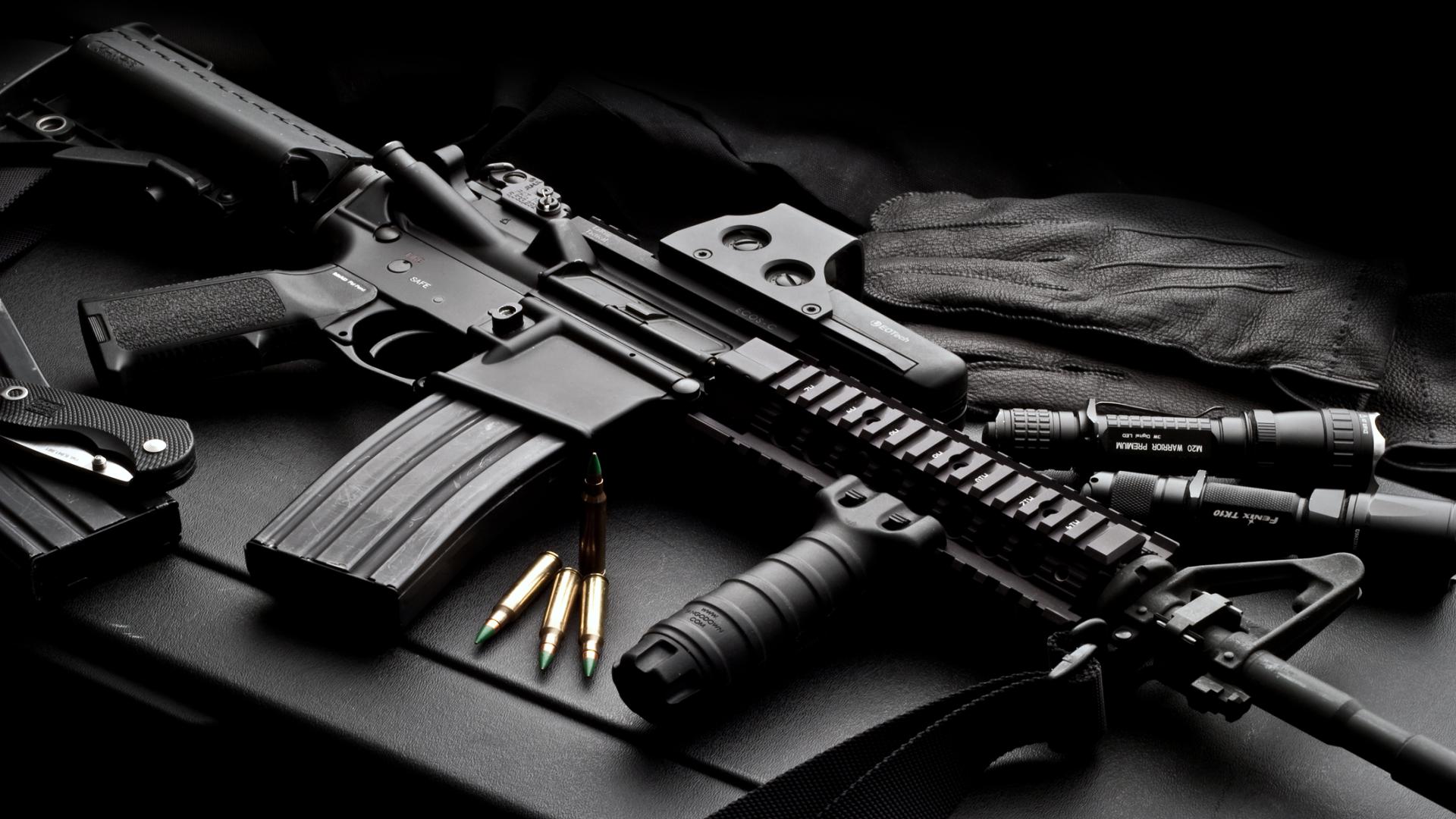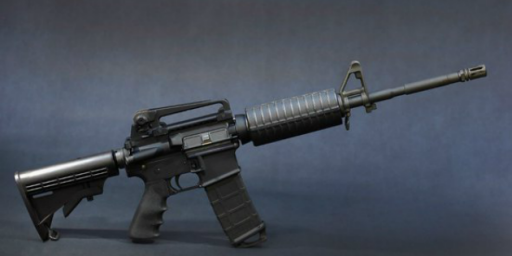New Washington State Law Bars ‘Assault Weapons’ Sales To People Under 21
Washington has become the latest state to ban the sale of semiautomatic assault rifles to persons under 21.

As of the start of the year, it is illegal in the State of Washington for anyone under the age of 21 to purchase a semiautomatic rifle:
People under 21 are no longer able to buy semiautomatic assault rifles in Washington as of Jan 1. It is the first of several new state measures intended to reduce gun violence. The National Rifle Association has already filed suit.
Previously, state law barred the assault weapons’ sale to those under 18. The new rules, approved by voters in a ballot initiative in November, come alongside dozens of moves by other states to strengthen gun control regulations in the absence of federal action.
“It is a meaningful step in the right direction,” said Christian Heyne, legislative director at the Coalition to Stop Gun Violence, on Washington’s initiative. “Gun violence on the whole is such a complex problem. We need to have complex solutions, comprehensive solutions. This is a part of that conversation.”
In addition to the age restrictions, Washington’s new rules state that gun dealers must wait 10 days before delivering semiautomatic assault rifles they sell. That is designed, in part, to prevent impulsive action. The rules also require anyone buying a semiautomatic assault rifle to have completed a gun safety training in the last five years. The measure also imposes criminal penalties for unsafe gun storage, and requires more extensive background checks for purchases of the assault weapons
Most of the new rules take effect in July.
“Every component is extremely important,” said Renee Hopkins, chief executive of the Alliance for Gun Responsibility, the group that sponsored the ballot initiative. “This package really looks to reduce suicide, reduce accidental shootings and also reduce everyday gun violence, interpersonal gun violence, that we see playing out.”
The Nov. 6 ballot initiative passed with more than 59 percent of the vote.
According to the Giffords Law Center to Prevent Gun Violence, state legislatures in 2018 passed 69 gun control measures, more than any other year since the Newtown, Conn., massacre in 2012, and more than three times the number passed in 2017. They included adding or improving state background checks, increasing regulations for concealed firearms and restricting firearm use for domestic abusers.
Opponents of Washington’s ballot initiative said its provisions to safely store guns would make them “unavailable” for self-defense. It also said that banning sale of semiautomatic assault rifles to 18- to 20-year-olds “would leave already vulnerable segments of the population defenseless to attack.” The N.R.A. and the Second Amendment Foundation have filed a lawsuit saying that the age restrictions violate the Constitution.
But gun control groups say public pressure has been mounting in response to recent high-profile mass shootings, including the slaughter at a country musical festival in Las Vegas that left 58 people dead and hundreds wounded in October 2017; and multiple shootings in 2018 at schools around the country, particularly at Marjory Stoneman Douglas High School in Parkland, Fla. In that shooting, a 19-year-old man killed 17 people with an AR-15 semiautomatic rifle in February.
Mr. Heyne said Washington’s move, while not unique, is a “bellwether” for what could happen in the rest of the country.
As was the case in Florida, where a similar law was passed in the wake of the Parkland shootings last February, it was already illegal under Washington law and Federal law for anyone under 21 to purchase handguns and several other types of weapons so this isn’t necessarily surprising that this move, which polling has indicated, is generally widely supported, was undertaken in the Evergreen State. Indeed, one can argue that there was no logical reason to raise the minimum age to purchase these types of weapons. Indeed, one could argue that there is a better argument to raise the age limit for these weapons than there is for handguns. Not unexpectedly, though, as they did with respect to the Florida law, the National Rifle Association and the Second Amendment Foundation have filed suit against the Washington law. While I have not seen a copy of the Complaint in that case, one presumes that it is largely identical to the one filed in Florida and that it suffers from the same legal defects.
With respect to the Second Amendment claims, for example, the argument that age restrictions on the sale and ownership of weapons are per se unconstitutional seems to be rather weak even when you take the Supreme Court’s ruling in the landmark case District of Columbia v. Heller into account. In that case, of course, the Court ruled for the first time that the right protected by the Second Amendment was an individual right that was, at the very least, intended to protect an individual’s right to own weapons to defend themselves, their homes, and their families. As a result, the Court held that the District of Columbia’s restrictive law on handgun ownership violated the Second Amendment Two years later the Court extended that ruling to the states in McDonald v. Chicago. In making that ruling, though, the late Justice Antonin Scalia specifically noted in his majority opinion in Heller that the right was not absolute:
Like most rights, the right secured by the Second Amendment is not unlimited. From Blackstone through the 19th-century cases, commentators and courts routinely explained that the right was not a right to keep and carry any weapon whatsoever in any manner whatsoever and for whatever purpose. See, e.g., Sheldon, in 5 Blume 346; Rawle 123; Pomeroy 152-153; Abbott 333. For example, the majority of the 19th-century courts to consider the question held that prohibitions on carrying concealed weapons were lawful under the Second Amendment or state analogues. See, e.g., State v. Chandler, 5 La. Ann., at 489-490; Nunn v. State, 1 Ga., at 251; see generally 2 Kent *340, n. 2; The American Students’ Blackstone 84, n. 11 (G. Chase ed. 1884). Although we do not undertake an exhaustive historical analysis today of the full scope of the Second Amendment, nothing in our opinion should be taken to cast doubt on longstanding prohibitions on the possession of firearms by felons and the mentally ill, or laws forbidding the carrying of firearms in sensitive places such as schools and government buildings, or laws imposing conditions and qualifications on the commercial sale of arms.We also recognize another important limitation on the right to keep and carry arms. Miller said, as we have explained, that the sorts of weapons protected were those “in common use at the time.” 307 U. S., at 179. We think that limitation is fairly supported by the historical tradition of prohibiting the carrying of “dangerous and unusual weapons.” See 4 Blackstone 148-149 (1769); 3 B. Wilson, Works of the Honourable James Wilson 79 (1804); J. Dunlap, The New-York Justice 8 (1815); C. Humphreys, A Compendium of the Common Law in Force in Kentucky 482 (1822); 1 W. Russell, A Treatise on Crimes and Indictable Misdemeanors 271-272 (1831); H. Stephen, Summary of the Criminal Law 48 (1840); E. Lewis, An Abridgment of the Criminal Law of the United States 64 (1847); F. Wharton, A Treatise on the Criminal Law of the United States 726 (1852). See also State v. Langford, 10 N. C. 381, 383-384 (1824); O’Neill v. State, 16 Ala. 65, 67 (1849); English v. State, 35 Tex. 473, 476 (1871); State v. Lanier, 71 N. C. 288, 289 (1874).
We also recognize another important limitation on the right to keep and carry arms. Miller said, as we have explained, that the sorts of weapons protected were those “in common use at the time.” 307 U. S., at 179. We think that limitation is fairly supported by the historical tradition of prohibiting the carrying of “dangerous and unusual weapons.” See 4 Blackstone 148-149 (1769); 3 B. Wilson, Works of the Honourable James Wilson 79 (1804); J. Dunlap, The New-York Justice 8 (1815); C. Humphreys, A Compendium of the Common Law in Force in Kentucky 482 (1822); 1 W. Russell, A Treatise on Crimes and Indictable Misdemeanors 271-272 (1831); H. Stephen, Summary of the Criminal Law 48 (1840); E. Lewis, An Abridgment of the Criminal Law of the United States 64 (1847); F. Wharton, A Treatise on the Criminal Law of the United States 726 (1852). See also State v. Langford, 10 N. C. 381, 383-384 (1824); O’Neill v. State, 16 Ala. 65, 67 (1849); English v. State, 35 Tex. 473, 476 (1871); State v. Lanier, 71 N. C. 288, 289 (1874).
While the Court has not issued any subsequent rulings defining the exact contours of what is and is not an acceptable restriction under the Second Amendment, many Federal Courts have done so, and it does provide us with somewhat of a guide in determining how the age restriction is likely to be viewed by the courts that consider it while the case is pending. Over the ten years since Heller four separate Federal Courts of Appeal have upheld laws banning so-called “assault weapons,” while others have upheld other restrictions such as waiting periods, concealed carry laws, and other laws that are arguably far more restrictive than the age restriction set forth in Washington’s law. The Supreme Court, meanwhile, has declined to accept any of these cases for review, which seems to be at least somewhat of a tacit admission on the part of the Justices that there are currently not five Justices on the Court who would strike down such laws, or that there are even four who would accept such cases for review. Given that, it seems unlikely that the Washington law would fare any worse than the far more restrictive laws that were at issue in the cases that the Supreme Court declined to hear.
Based on the press releases linked above, it appears that the N.R.A. also raises an argument under the Equal Protection Clause to the Fourteenth Amendment similar to those raised by the Florida lawsuit. As a general rule, equal protection claims such as this are judged based on differing levels of scrutiny depending on the type of discrimination being alleged. Discrimination based on race and ethnicity, for example, is subjected to what is generally called “strict scrutiny,” which is the highest level of scrutiny available under the law. When strict scrutiny is applied to a law alleging discrimination, the relevant government authority must show that the law is (1) justified by a “compelling governmental interest,” (2) that the law is narrowly tailored to achieve that interest, and (3) that it is the least restrictive means available to achieve that objective. This means, of course, that most laws that are judged using a strict scrutiny standard fail to meet the requirements and end up being found to be unconstitutional. One step below strict scrutiny is a standard of review that has come to be known as intermediate scrutiny. Under this level of review, the jurisdiction defending the law being challenged must show that it furthers an important government interest by means that are substantially related to that interest. In the past, this level of scrutiny has been held to apply to gender-based discrimination, discrimination based on illegitimacy, and, in some cases, sexual orientation, although it’s worth noting that there is at least some support from lower-court rulings in the cases that dealt with challenges to bans on same-sex marriage that sexual orientation should be subjected to a somewhat higher level of scrutiny. Additionally, some states have established either through legislation or court rulings that discrimination based on sexual orientation should be evaluated based on a strict scrutiny standard. The lowest level of review is called the rational basis test. Under this level of review, a government defending a challenged law or policy is merely required to show that the law in question serves a legitimate government interest and that law in question is rationally related to achieving that interest. Needless to say, a law that is evaluated based on this standard will generally be upheld as long as the state can put forward a rational basis to support it.
As a general rule, laws that purport to discriminate based on age have been held to be subject to simple rational basis scrutiny. What this means is that a policy or law that discriminates based on age generally must past what is known as a “rational basis” review, meaning that it will be considered permissible as long as there is some rational basis for that law or policy. In the case of gun sales, it seems fairly clear that the argument can be made that states and localities have a rational basis to discriminate based on age when it comes to the sale of something as dangerous as a weapon. This would seem to be especially true in light of the fact that it is already illegal under Federal law and the law of most states for anyone under 21 to purchase a handgun and that, until now, persons aged over 18 but under 21 have only been able to purchase weapons such as shotguns, hunting rifles, and other “long guns,” including so-called “assault weapons.” It’s also noteworthy that the Federal law regarding handgun sales was upheld by the Fifth Circuit Court of Appeals in a 2013 ruling, which the Supreme Court declined to review. Taking this into account, the fact that Washington joining other states that also ban people under 21 from being able to legally purchase any gun would seem to withstand the appropriate level of Equal Protection scrutiny. After all, if the Federal Government can ban handgun sales to people under 21, there doesn’t seem to me to be any rational basis for saying that a state is forbidden from expanding that ban within their borders to include other types of guns.






https://www.salon.com/2017/11/08/american-hyper-capitalism-breeds-the-lonely-alienated-men-who-become-mass-killers_partner/
Any Assault Weapons ban should only apply to registered Democrats.
Oh god, does this mean we here in the comments section are going to be inundated with another round of gun nuts lecturing us about how we have no right to an opinion because we don’t understand the difference between a thirty ought six cig sour and a semi-bumped 38 caliber derringer with an uzi clip?
@MarkedMan: IIRC the last few gun related posts didn’t generate the 100+ comment threads OTB used to get. It’ll be interesting to see how this goes.
My first blush reaction is good, win or lose, bleed the NRA dry. I’ve been seeing stories that they’re hurting financially. Membership and contributions are off with Trump. Seems maybe some of the gun enthusiasm was driven by having a black prez. Hoocudanode.
@MarkedMan: if you can’t give the perfect dictionary distinction between a magazine and a clip, then you’re not allowed to have an opinion on dozens of school children being murdered.
/Dipshit
😀
Perhaps a good time to review Linda Greenhouse’s piece from last week in the NYT on the Supremes and gun decisions.
I have no idea how the conservative majority will rule when and if the Supremes accept another gun case, but I believe that they would take seriously Scalia admonitions on the potential limitations of 2nd amendment rights described in Heller. Particularly when the limitation on gun ownership is limited in scope.
@gVOR08:
There are any number of activities that have been popular with earlier generations that millennials have shown little interest in. I wonder if that is also the cases with guns?
You know how when you were a child and discovered you could cover the whole Sun with your thumb, you wondered why it was still light out if you’ve just covered the whole effing Sun?
@Paul L.: Dude, it’s the unregistered Democrats that you have to worry about.
Interesting issue that I have not heard mentioned yet is that as I understand the law, a person can serve in the US Army at age eighteen and be an expert marksman, fighting overseas in real shooting battles, yet comes home and in some places is “too young” to buy a gun legally.
Another point that I did not see mentioned is that this law does not outlaw giving someone under twenty one years old a gun or letting them use one, as a parent or friend might do.
Side question: The only gun I have is a 1917 “Danzig” bolt action rifle, probably a type of Mauser. I have never fired it: indeed it does not have a firing pin. It is very heavy, and in great condition. I wonder if anyone here has any knowledge or experience with this type. I do not have a permit – I was told long ago it is an antique and does not need one. Not that it could hurt anyone, unless they dropped it on their foot. How in the world did soldiers could carry something that heavy for hours at a time.
@Sleeping Dog: The NRA has had to lay off staffers. So sad.
Given their relationship with a certain unregistered Russian agent (no, not that one, Butina), and the facts that they took in a lot of Russian money while spending massively for Republican candidates in 2016, I have no sympathy.
There should be gun training and safety organizations — they serve a valuable purpose in a country with this many guns — but the NRA isn’t that organization anymore.
I recently relocated to the Olympia area of Washington state. In a rural area. The amount of gunfire that occurs every day from various directions is astonishing. They talk about gun rights being associated with hunting, but what I hear is high calibre, rapid fire gunshots that would turn any game into hamburger. These people have a mental issue. I definitely voted to restrict assault weapon sales. I would vote to restrict gun use altogether.
@Tyrell: Perhaps a https://en.wikipedia.org/wiki/Kb_wz%2E_98a?wprov=sfti1
When I was at Univ of Illinois I heard a retired prof who was doing a history of the school, a Civil War era land grant college, talk about the reqirement that all students receive military training and fire for record. 15 year old students had trouble with 9 lb Springfield rifles. A WWI Mauser similar to yours was about the same weight. A WWII M1 Garand was about the same, and a modern M4 about 7-1/2 lb.
That the Army uses 18 year olds does not imply they should be allowed to use pretend assault rifles unsupervised.
@Just nutha ignint cracker: Well, of course fear the unregistered democrats — just keep on ignoring all of us unregulated and unregistered flat-earthers!
Of course, as in many cases of legislative doofy-headedness, the devil is in the details. The legal definition of what an assault rifle hasn’t yet been released by the appropriate regulatory agency in Washington, and some stores have announced that they are at risk for selling ANY semi-automatic weapons to those under 21 until the state gets their act together.
@flat earth luddite:
You make that sound like it’s a bad thing.
@gVOR08: I am not sure that there is a consistent definition of “assault rifle”, automatic, machine gun, tommy gun, or rapid fire rifle. “AR” does not stand for assault rifle much to the surprise of many people.
My gun knowledge (and skills) are limited to long distance squirt guns and those that shoot the little foam darts. I have studied the Gatling Gun and I would like to have a flintlock. Flintlocks have a distinctive sound unlike any other: clean, clear. I also have studied the various arms and artillery used in the Revolutionary War and the War of 1812. Read the history of Valley Forge and how General Von Stueben helped train the colonial army.
I certainly agree that the automatic rifle should not be used in hunting. What happened to the skills that hunters used to pride themselves on?
The legal definition is loose, hence my habit of referring to the semi-automatic civilian poseur weapons as “pretend assault rifles”. Up to me, we’d just ban civilian use of semi-auto weapons, failing all, at least semi-auto long guns.
@flat earth luddite: I already know you’re dangerous.
@Tyrell: ” What happened to the skills that hunters used to pride themselves on?” To the best of my knowledge, hunters still have it. But I live in hunting country (never been a hunter myself). In my area bow hunting is big.
ETA: Is it different where you live? No pride of ability and skill in the hunters?
@Just nutha ignint cracker: Not as many hunters around here as used to be when I was a teen. Evidence of that is an abundance of deer, rabbits, and squirrels. Car repair shops are booked up with damages caused by deer.
The high schools used to have competition rifle teams, but that went out years ago as interest wained.